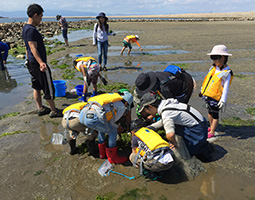Home > Highlighting JAPAN > Highlighting Japan April 2018 > The Maritime Nation of Japan
Highlighting JAPAN


The Project to Restore a Bountiful Sea
The government, private sector, NPOs, scholars and citizens have united to restore Osaka Bay to its former beautiful and bountiful state.
Osaka Bay is an enclosed coastal sea area situated at the eastern end of the Seto Inland Sea with two bay entrances, the Akashi and Kitan Straits. Distinct characteristics of the bay are a hinterland of mountains from 500 to 1,000 meters in height such as Mount Rokko and Mount Ikoma, and a vast catchment area into which many rivers flow.
Spanning seven prefectures, Osaka Bay is a focal point of population and industry and had long played a role as a location for industry, trade and fishing. Up until around 1955, the Bay was dotted with sandy beaches that locals enjoyed for bathing and clamming, which cultivated an intimate connection between people and the sea. However, during Japan’s rapid economic growth period, land reclamation advanced along coastal areas as activity picked up in the region as a hub of distribution and production. As a result, natural beaches, seaweed beds and tidelands shrank or disappeared, developing a body of water in which seawater could more easily stagnate. Progress was also made in the development of shore protection facilities to safeguard the livelihoods of people in the surrounding area. As the population grew and industry developed in the closed-off section of the bay, sea pollution and waste increased, creating a compromised habitat for marine life.
In December 2001, the Office for Promotion of Regional Revitalization, Cabinet Office adopted “Sea Regeneration” as an urban regeneration project, and in July 2003, Osaka Bay Regeneration was established as a government-led effort to pursue environmental improvements to Osaka Bay. In the years since, Osaka Bay Regeneration has worked with many different organizations including citizens, NPOs, scholars and companies to regenerate Osaka Bay by restoring sea conditions, addressing water pollution, and by making improvements to forests and the rivers that flow into Osaka Bay.
“Large factories had been built on many plots of reclaimed land around the closed-off sections of Osaka Bay, including an industrial zone for heavy and chemical industries, and we suppose that depressions scooped out of the seabed due to reclamation work and changing tidal streams from reclaimed land have had an effect on the environment in Osaka Bay, such as what we have seen with blue tides and red tides associated with poor oxygen water mass or eutrophication,” says Yoshiki Matsui, Senior Officer for Engineering Planning, Planning Department Office of the Ministry of Land, Infrastructure, Transport and Tourism, Kinki Regional Development Bureau.
Osaka Bay Regeneration has been pursuing initiatives to restore what was once a beautiful, familiar and bountiful Naniwa Sea (literally, “garden of fish”; “Naniwa” was the name given to the Osaka Bay area on account of its abundant marine life). The organization has three groups focused on land, sea and monitoring, and conducts a range of activities aimed at restoring the environment. The Sea Group concentrates on refilling seabed depressions, while the Land Group works on development of forest and sewage treatment facilities. The Monitoring Group conducts general surveys of water quality and living organisms to ascertain the effects of improvements, and conducts activities to understand the state of the environment in Osaka Bay.
“There are limits to what the government can do alone in restoring Osaka Bay. We need to gain understanding of residents in inland areas like Shiga and Kyoto prefectures that are in the hinterland zone of Osaka Bay. Rain that has fallen in inland areas and melting snow flows into Osaka Bay from Lake Biwa in Shiga prefecture along the Yodogawa River. Even for people living in regions that are not directly connected to Osaka Bay, it is important to have an awareness of the environmental protection that is closely linked to daily activities, such as reducing waste volume and releasing clean water so as not to place a burden on the environment,” says Matsui.
With the aim of restoring the beautiful, familiar and plentiful sea and regenerating Osaka Bay into something citizens are proud of, Osaka Bay Regeneration is working on activities in coordination and cooperation with a wide range of entities that include industry, government and academia. For example, the organization holds forums and events for citizens to inform them of the condition of Osaka Bay, and as part of the citizen group-led Osaka Bay General Survey of Marine Life, 1,098 people from twenty-five groups have taken part in activities to ascertain the aquatic environment of Osaka Bay. The survey involves verifying the presence of various fish and shellfish, as well as a finless porpoise, a member of the dolphin family.
“It takes a lot of time and effort to return the sea to a fertile state. In order to pass on a beautiful sea to younger generations, government organizations are taking a leading role in innovative efforts to restore Osaka Bay,” says Matsui.
Osaka Bay Regeneration will continue to promote activities to restore Osaka Bay while incorporating people’s feedback on its efforts.
© 2009 Cabinet Office, Government of Japan








